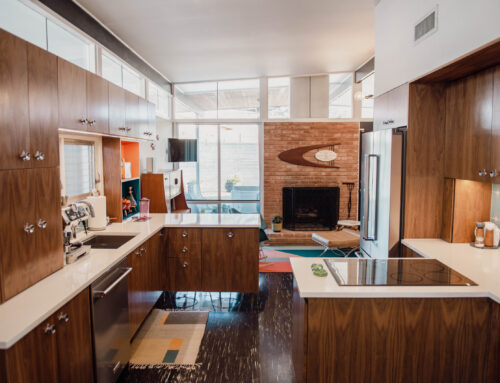For Rhonda Clifford, Lisa Johnson and Christine Scott, having a child isn’t a liability at their new place of work. It’s a prerequisite.
Because after a day’s work keeping their homes and families running smoothly, these neighborhood mothers often stay up into the wee hours of the morning pondering some weighty questions: which vintage scarf would look best on the bottom of those new Levis, or what combination of beads and wires would make the best bracelet or what type of ribbon would a little boy like most on his blue nap-mat?
It’s all in a day’s work for these full-time mothers and part-time, home-based entrepreneurs.
“Children are fabulous, but sometimes at the end of the day, I’ve made dinner, I’ve made sure their clothes are clean, I’ve read to them,” Scott says. “You do all this stuff to make sure that they’re all at 100 percent, and you wonder what you did to fulfill yourself today. At the end of the day, I may not make much money doing this, but I want to say: I do this, and this is my thing.”
Home grown / Rhonda Clifford worked for 17 years in the jewelry business, and she took six months off after the birth of her daughter Nicole, now 14 months old, to decide what her next move would be. Her home-business wasn’t an accident; it was inevitable.
“I loved my job and my position,” Clifford says about being a buyer with Castle Gap Silver Jewelry in Preston Center. “I planned on going back, but knew I couldn’t. I’m at home with (Nicole), and she’s number one.
“I’ve always been so independent and used to getting up and going to work and working insane hours, so I almost need this for myself.”
Clifford’s experience in the jewelry retail industry lent her an edge in starting Clifford Creations.
“I learned a lot about smart buying and quality materials.”
Past customers and her former employers have helped by showcasing her jewelry along-side some of the Native American creations she purchased for the store.
“I bought jewelry from people making it at their table, mainly Native Americans, and now I’m making it at my kitchen table,” she says, describing her main work station, which is covered in all kinds of wires and measuring tools, beads and more beads.
“Nicole has already figured out that if she puts her hands on the table, she can bring some beads down,” she laughs.
In addition to Castle Gap’s help, Clifford has been busy doing sales parties for her merchandise in peoples’ homes. During the holiday season, she found herself with “more volume than one person should have, selling a couple thousand dollars a month.
“When I’m done for the day with Nicole, and the house is quiet, I’ll spend a couple of hours…well,” she reconsiders, “sometimes six or seven hours, just losing myself and creating; not really thinking.”
Her jewelry ranges from the trendy, young inexpensive ($4-plus) baubles of beaded bracelets, earrings and necklaces to the hot-block letter creations kids and parents alike are wearing these days, to the semi-precious stone creations ($200-plus) she designs with a more sophisticated look in mind.
“Collecting and making jewelry is my passion.”
A dedicated worker, it seems natural that Clifford has aggressively grown her business in just six months, but the irony of what she has accomplished from home is not lost on her.
“I quit retail,” she says, “so I wouldn’t tie up my holidays around sales instead of family, and I’m backed up on orders for the holidays!”
Mommy, why do you make things? / Lisa Johnson and business partner Susan Nix started Bare Hugs in 1997. Johnson’s daughter and son were toddlers, and Nix’s daughter was in middle school when the two neighborhood mothers began selling the hooded towels Johnson was making out of her home.
Their inventory consists of three products: hooded towels for toddlers, body wraps (a larger version of the hooded towel) for older children (both $35), and custom-made nap mats ($40). Each is made of terry cloth because “it’s absorbent, easy-to-wash and lasts forever,” and each is personalized with ribbons and monograms of the customers’ choosing. The partners run their business in assembly-line fashion: Johnson does the sewing. Nix does the bookkeeping, and the monogramming is outsourced. With the chaos of raising kids, Johnson says the business stays as predictable as possible.
“I would love to grow this business, but I just don’t think that right now is the season for that,” she says.
Spurred by the initial response they received from friends, and friends of friends, Johnson and Nix began to frequent trade shows to expand Bare Hugs’ customer base. They found that a market exists for their niche gift-items, but that becoming better-known and growing the business requires a price they refuse to pay.
“I’m not in this to make a million dollars,” Johnson says. “That’s not my goal. This is like a bonus we pay ourselves each year. I still want to be primarily a mother first – that’s why I quit my job in banking. So, we really are trying to contain the growth.”
The only business Bare Hugs currently solicits is word-of-mouth, Johnson says.
“We do about 500-800 items a year now. It just is a domino effect.”
It’s an interesting approach to running a business, but motherhood was the reason Johnson started the business in the first place, so it makes sense that the two parts of her life are inextricably connected.
“When you become a mom, it’s a way to channel your resources and your creativity. It’s important that my children see I can do something well outside of raising them. Mom can earn money too, mom can be resourceful, mom can be creative, but I want to be at home when my kids get home and be able to have lunch with them at school when they want to have lunch.”
“So, this is a business, eh?” / Christine Scott, a mother of three preschool-age boys, is the self-described “new kid on the block.”
“I had always told my husband that when the kids all go to school, I want to go back and study fashion design, but I woke up one night and thought:Why do I need to go back to school to do this? I can play around with my own stuff, and if I get it wrong, who cares?” Scott says.
So she made time to craft something other than a good human being – accessorized jeans.
Scott only recently crossed the sacred threshold in establishing a hobby as a business. Six months after beginning to experiment, Christine’s Jeans, a formality she is not accustomed to offering yet, was formed.
“At first, I didn’t think of it as a business,” Scott says. “It was: I’m having a great time, I’m getting a better wardrobe.”
But with a little querying from her business-minded husband – “Now, you’re doing that for free?” – Scott realized it was time to take the leap.
“I considered it a hobby until I started charging people.”
Averaging about five jeans per week, Scott does most of her sewing while the kids are asleep.
“My first priority is my kids,” she says.
She began by buying large quantities of vintage scarves and all the Levis she could find. Soon, however, those experimentations became merchandise, and Scott was constantly on the lookout for more jeans as business went “beyond just my little realm of friends.”
Scott’s knowledge of where to go next is a bit shaky.
“I am so in the infancy of it. There are a lot of aspects that I haven’t figured out yet. Am I going to be spending 20 hours a week in thrift stores?
“Should I go to a wholesale jeans manufacturer?”
There are more questions than answers in starting a business, but these neighborhood women know one thing for certain: Not a one of them wants to grow their business if it means taking time away from their families.
“It can be as big or as little as I want it to be,” Clifford says. “I don’t have a big master plan, but the business will probably grow.
“I’m already busier than I thought I would be at this point.”





